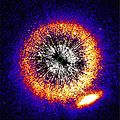Top Qs
Timeline
Chat
Perspective
HD 107146
Star in the constellation Coma Berenices From Wikipedia, the free encyclopedia
Remove ads
HD 107146 is a star in the constellation Coma Berenices that is located about 90 light-years (28 pc) from Earth.[10] The apparent magnitude of 7.028 makes this star too faint to be seen with the unaided eye.
The physical properties of this star are similar to the Sun, including the stellar classification G2V,[4] making this a solar analog.[11] The mass of this star is about 109% of the solar mass (M☉) and it has about 99% the radius of the Sun (R☉).[7] It is a young star with an age between 80 and 200 Myr.[10] The axis of rotation is estimated at 21+8
−9 degrees to the line of sight and it completes a rotation in a relatively brief 3.5 days.[7]
Remove ads
Circumstellar disc
Summarize
Perspective
In 2003, astronomers recognized the excess infrared[12] and submillimeter[10] emission indicative of circumstellar dust, the first time such a debris disk phenomenon was noted around a star of similar spectral types to the Sun, though having a much younger age. In 2004 the Hubble Space Telescope detected the presence of a spatially resolved disk surrounding the star.[8][13]
The star's circumstellar disc has dimensions of approximately 210 × 300 AU.[10] The dusty ring is cool, with a temperature of 51 K (−222 °C; −368 °F), and has a dust mass of 0.250±0.004 M🜨 and nearly no gas.[14] Analysis of the debris disk in the far-infrared and submillimeter wavelengths, carried out using the Hubble Space Telescope, suggests the presence of small grains in the disk.[8] The disk appears to be slightly elongated to form an ellipse with its minor axis at a position angle of 58° ± 5°; working under the assumption that the disk is in fact circular gives it an inclination of 25° ± 5° from the plane of the sky.[8] An analysis published in 2009 suggests the possible presence of a planet at a separation of 45-75 AU,[11] in the wide gap centered at 75.4 AU[14] which may be carved by the planet, but no planet with mass exceeding 1-2 MJ was observed in the gap.[15]
Remove ads
Gallery
- Transit of Vermin Galaxy behind HD 107146.[16]
- False colour image of HD 107146 taken by the Hubble Space Telescope, showing its circumstellar disc. The right side of the disc is brighter due to inclination of the disc to the line of sight and preferential forward scattering of the light from the star.
References
Wikiwand - on
Seamless Wikipedia browsing. On steroids.
Remove ads



